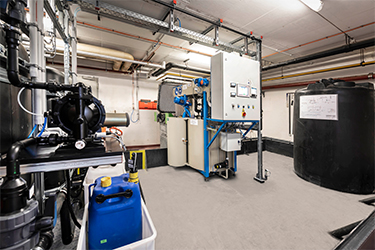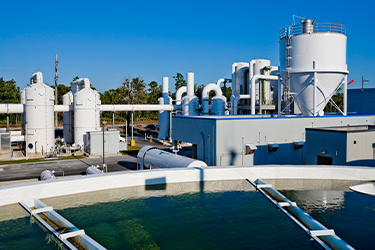-
AOP Processes
Advance Oxidation Process (AOPs)
A set of chemical treatment procedures known as AOPs are designed to remove organic and sometimes inorganic materials in water and wastewater. In these processes, oxidation through reactions with hydroxyl radicals (-OH) result in degradation of materials. In real applications of wastewater treatment, this term usually refers more specifically to a subset of chemical processes that employ ozone (O3), hydrogen peroxide (H2O2) and/or UV light. The most widely applied conventional AOP systems has been the H2O2/UV, O3/UV, H2O2/O3 and H2O2/O3/UV processes. The AOP process is successfully used to decompose many hazardous chemical compounds to acceptable levels, without producing additional hazardous by-products or sludge which requires further handling.

-
Disinfection Systems
Disinfection:
Disinfection is accomplished both by filtering out harmful micro-organisms and also by adding disinfectant chemicals. Water is disinfected to kill any pathogens which pass through the filters and to provide a residual dose of disinfectant to kill or inactivate potentially harmful micro-organisms in the storage and distribution systems. Possible pathogens include viruses, bacteria, including Salmonella, Cholera, Campylobacter and Shigella, and protozoa, including Giardia lamblia and other cryptosporidia. Following the introduction of any chemical disinfecting agent, the water is usually held in temporary storage – often called a contact tank or clear well to allow the disinfecting action to complete.
Chlorine disinfection:
The most common disinfection method involves some form of chlorine or its compounds such as chloramine or chlorine dioxide. Chlorine is a strong oxidant that rapidly kills many harmful micro-organisms. Because chlorine is a toxic gas, there is a danger of a release associated with its use. This problem is avoided by the use of sodium hypochlorite, which is a relatively inexpensive solution that releases free chlorine when dissolved in water. Chlorine solutions can be generated on site by electrolyzing common salt solutions. A solid form, calcium hypochlorite, releases chlorine on contact with water. Handling the solid, however, requires greater routine human contact through opening bags and pouring than the use of gas cylinders or bleach which are more easily automated. The generation of liquid sodium hypochlorite is both inexpensive and safer than the use of gas or solid chlorine.

-
Electrocoagulation Process
Electrocoagulation (EC)
Electrocoagulation (EC) technology is a treatment process of applying electrical current to treat and flocculate contaminants without having to add coagulations.Coagulation occurs with the current being applied, capable of removing small particles since direct current applied, setting them into motion. Also electrocoagulation could reduce residue for waste production.
Electrocoagulation consists of pairs of metal sheets called electrodes, that are arranged in pairs of two—anodes and cathodes. Using the principles of electrochemistry, the cathode is oxidized (loses electrons), while the water is reduced (gains electrons), thereby making the wastewater better treated. When the cathode electrode makes contact with the wastewater, the metal is emitted into the apparatus.
When this happens, the particulates are neutralized by the formation of hydroxide complexes for the purpose of forming agglomerates. These agglomerates begin to form at the bottom of the tank and can be siphen out through filtration. However, when one considers an electrocoagulation apparatus, the particulates would instead float to the top of the tank by means of formed hydrogen bubbles that are created from the anode. The floated particulates can be skimmed from the top of the tank.
To consider how effective the EC reactor can be, one must consider the following inputs or variables wastewater type, pH, current density, type of metal electrodes (aluminum, steel, iron), number of electrodes, size of electrodes, and configuration of metals. These variables would affect the overall treatment time, kinetics, and also the removal efficiency measured.
Electrocoagulation is an alternative method to classic chemical coagulation for many reasons. EC is capable of reducing the need for chemicals due to the fact that the electrodes provide the coagulant. However, many individuals still use chemical coagulants to attempt to enhance treatment. Traditionally, chemical coagulation involves the use of alum (aluminum sulfate), ferric chloride (FeCl3), or ferrous sulfate (Fe2SO4) which can be very expensive depending on the volume of water treated. When applying the coagulant, the coagulant performs a similar function as the electrodes, neutralizing the charge of the particulates, thereby allow them to agglomerate and settle at the bottom of the tank. In addition, electrocoagulation is capable of reducing waste production from wastewater treatment and also reduces the time necessary for treatment.
- NOX Process
NITROGEN OXIDES (NOx)
NOx processes is a new possi-bility of stimulating and controlling the activ-ity of the Nitrosomonas-like microorganisms by the addition of nitrogen oxides. The Nitrosomonas strains have a versatile metabolism and are able to gain energy during the aerobic and anaerobic ammonia oxidation or by denitrification using hydrogen or organic compounds as electron donors.The anaerobic ammo-nia oxidation by Nitrosomonas is dependent on the nitrogen dioxide (NO2). The conversion of about 50% of the ammonia load to nitrite occurs and the nitrite produced is used as a terminal electron acceptor, which leads to N2 production.The Nitro-somonas eutropha consumes ammonia and NO2 at the ratio of approximately 1:1.An equivalent amount of NO is produced. Then, during denitrification of nitrite to N2 small amounts of N2O are produced. Trace amounts of gases NO and NO2 (NOx) can be added to induce a short-ened nitrification/denitrification route by Nitrosomonas and can therefore be the regula-tory signal for the denitrification activity. NO2 concentrations of up to 50 ppm have no toxic effects on Nitrosomonas eutropha but NO at concentration above 25 ppm inhibit the ammonia oxidation.
Consequently, in the NOx process, the nitrifi-cation part is more efficient due to a 50% lower oxygen demand whereas the following step demands up to 80% less organic matter for denitrification.There is a possibility of implementing this process in the existing treatment facilities with minimal financial efforts and minor changes in the operation strategy.
3NH4++3O2+3[H] → 1.5N2+3H++6H2O

